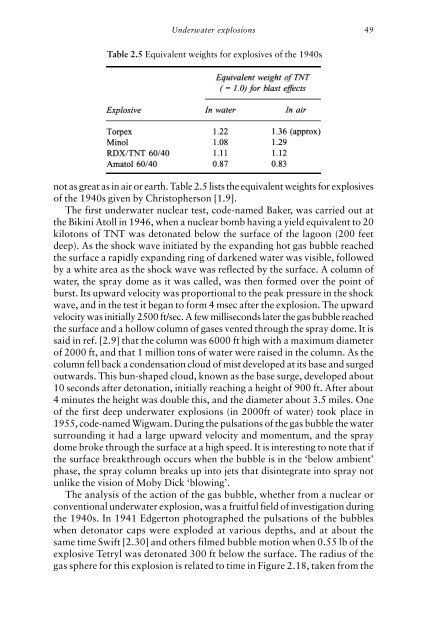A History of Research and a Review of Recent Developments
A History of Research and a Review of Recent Developments
A History of Research and a Review of Recent Developments
You also want an ePaper? Increase the reach of your titles
YUMPU automatically turns print PDFs into web optimized ePapers that Google loves.
Underwater explosions 49<br />
Table 2.5 Equivalent weights for explosives <strong>of</strong> the 1940s<br />
not as great as in air or earth. Table 2.5 lists the equivalent weights for explosives<br />
<strong>of</strong> the 1940s given by Christopherson [1.9].<br />
The first underwater nuclear test, code-named Baker, was carried out at<br />
the Bikini Atoll in 1946, when a nuclear bomb having a yield equivalent to 20<br />
kilotons <strong>of</strong> TNT was detonated below the surface <strong>of</strong> the lagoon (200 feet<br />
deep). As the shock wave initiated by the exp<strong>and</strong>ing hot gas bubble reached<br />
the surface a rapidly exp<strong>and</strong>ing ring <strong>of</strong> darkened water was visible, followed<br />
by a white area as the shock wave was reflected by the surface. A column <strong>of</strong><br />
water, the spray dome as it was called, was then formed over the point <strong>of</strong><br />
burst. Its upward velocity was proportional to the peak pressure in the shock<br />
wave, <strong>and</strong> in the test it began to form 4 msec after the explosion. The upward<br />
velocity was initially 2500 ft/sec. A few milliseconds later the gas bubble reached<br />
the surface <strong>and</strong> a hollow column <strong>of</strong> gases vented through the spray dome. It is<br />
said in ref. [2.9] that the column was 6000 ft high with a maximum diameter<br />
<strong>of</strong> 2000 ft, <strong>and</strong> that 1 million tons <strong>of</strong> water were raised in the column. As the<br />
column fell back a condensation cloud <strong>of</strong> mist developed at its base <strong>and</strong> surged<br />
outwards. This bun-shaped cloud, known as the base surge, developed about<br />
10 seconds after detonation, initially reaching a height <strong>of</strong> 900 ft. After about<br />
4 minutes the height was double this, <strong>and</strong> the diameter about 3.5 miles. One<br />
<strong>of</strong> the first deep underwater explosions (in 2000ft <strong>of</strong> water) took place in<br />
1955, code-named Wigwam. During the pulsations <strong>of</strong> the gas bubble the water<br />
surrounding it had a large upward velocity <strong>and</strong> momentum, <strong>and</strong> the spray<br />
dome broke through the surface at a high speed. It is interesting to note that if<br />
the surface breakthrough occurs when the bubble is in the ‘below ambient’<br />
phase, the spray column breaks up into jets that disintegrate into spray not<br />
unlike the vision <strong>of</strong> Moby Dick ‘blowing’.<br />
The analysis <strong>of</strong> the action <strong>of</strong> the gas bubble, whether from a nuclear or<br />
conventional underwater explosion, was a fruitful field <strong>of</strong> investigation during<br />
the 1940s. In 1941 Edgerton photographed the pulsations <strong>of</strong> the bubbles<br />
when detonator caps were exploded at various depths, <strong>and</strong> at about the<br />
same time Swift [2.30] <strong>and</strong> others filmed bubble motion when 0.55 lb <strong>of</strong> the<br />
explosive Tetryl was detonated 300 ft below the surface. The radius <strong>of</strong> the<br />
gas sphere for this explosion is related to time in Figure 2.18, taken from the


